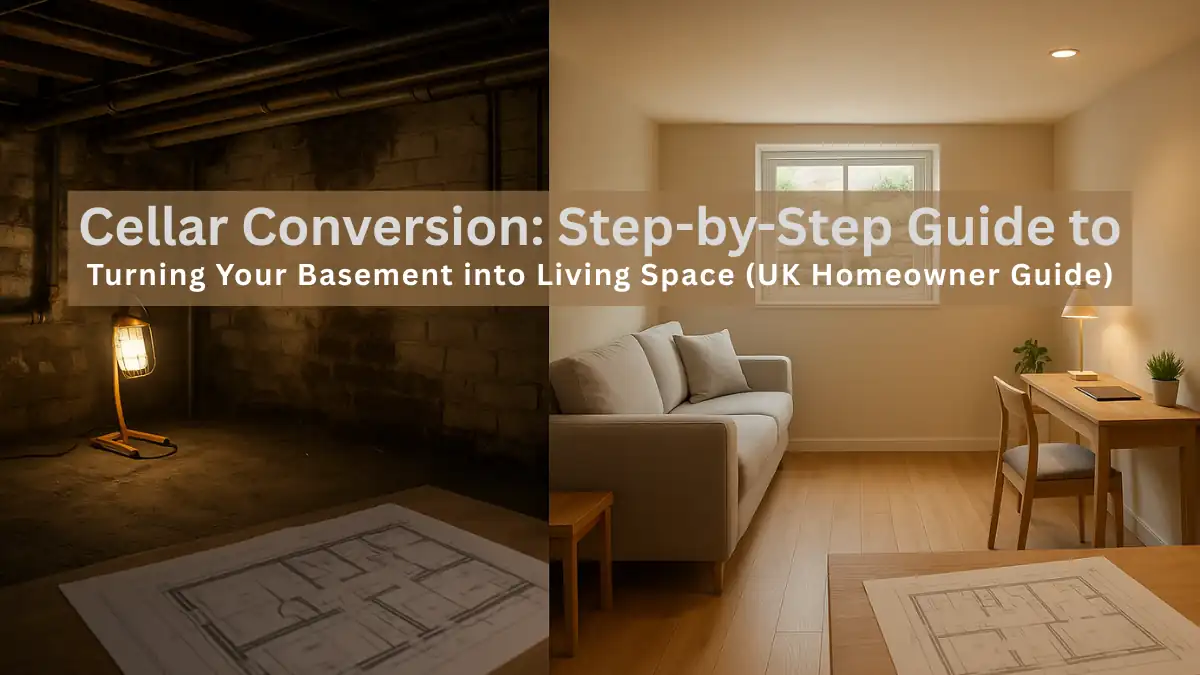Share this post:
Thinking about a cellar conversion?
Get an early sense of feasibility, costs, and permissions for your home and council area.
Converting a cellar is one of the smartest ways to unlock extra living space without altering your street elevation. This guide explains when you need planning permission, what Building Regulations will assess (structure, fire safety, damp, ventilation, stairs, electrics), realistic costs and timelines, plus a clear step-by-step process. We also flag local council quirks and common pitfalls so you can avoid delays and expensive rework.
What is a Cellar Conversion?
A cellar (or basement) conversion turns below-ground space into habitable rooms—typically a family room, office, bedroom with en-suite, utility or cinema. Many Victorian and Edwardian homes across London, the Home Counties and northern cities have underused cellars with good footprint but poor headroom and moisture control. With the right design and waterproofing strategy, they can become warm, dry, compliant living space that adds value.
Planning Permission vs Permitted Development (PD)
Many internal cellar conversions are classed as permitted development (PD) because they don’t change the external appearance of the house. However, PD does not remove your duty to comply with Building Regulations. You’ll likely need planning permission if:
- You’re lowering the floor (underpinning) to gain head height that affects drainage levels or structural arrangement.
- You’re adding lightwells, external stairs, doors or windows visible from the street or altering the principal elevation.
- The property is in a Conservation Area or is Listed (more control over external changes and sometimes internal fabric).
- It’s a flat/maisonette (PD rights are different or removed).
For planning policy overview, see the Planning Portal and GOV.UK planning guidance.
Building Regulations: What You Must Prove
Regardless of planning, Building Regulations approval is required for a cellar conversion. Inspectors will assess:
- Structure (Part A): any underpinning, new steels, load paths and wall/floor build-ups. You’ll usually need a structural engineer’s design.
- Fire Safety (Part B): protected escape route or compliant alternative (e.g., egress window/lightwell, linked smoke alarms, FD30 doors as needed).
- Damp & Waterproofing: Type A (barrier), Type B (integral) or Type C (cavity drain membrane) system—with continuity of protection at walls and floors.
- Ventilation (Part F): background and extract rates; risk of radon in certain postcodes.
- Thermal (Part L): insulation to floors/walls, thermal bridges, heating controls.
- Stairs (Part K/M): pitch, going/rise, handrails; adequate headroom on stair flight.
- Electrics (Part P): certification by a competent electrician.
Quick Costs Snapshot & Timelines
Cellar Conversion – Typical UK Costs (guide only)
- Basic conversion (no excavation): £1,400–£2,200/m² — insulation, services, finishes, Type C membrane, modest joinery.
- Excavation/underpinning to gain headroom: +£1,000–£1,800/m² on top (heavily site-dependent).
- Waterproofing systems: Type C membrane + sump/pump typically £80–£140/m² (plus pump kit £900–£1,800).
- Lightwell & egress window: £2,500–£6,500 each depending on detailing and drainage.
- Professional fees: plans & building-regs drawings, structural design, Building Control, surveys: commonly 10–15% of build cost.
- Timescales: design & approvals 4–10 weeks; construction 6–16+ weeks (longer with underpinning or complex drainage).
Need tailored figures for your home? See our Basement Conversions (Pillar) for a deeper dive or ask us for a project-specific estimate.
Not sure if your idea fits Permitted Development?
We’ll check your project against PD rules and let you know if you need a full planning application.
Step-by-Step: From Idea to Approval
| Step | What to Do | Output |
|---|---|---|
| 1. Feasibility | Measure head height, check drains, look for damp. Identify if excavation/underpinning is needed. Review timelines and risks. | Feasibility note; scope decision (conversion only vs excavation). |
| 2. Surveys & Design | Measured survey; concept layout; waterproofing strategy; stair/egress plan; services routes. Engage structural engineer early. | Proposed plans & sections; outline structural strategy. |
| 3. Permissions | Confirm PD or submit planning/LDC. If in Conservation Area or Listed Building, prepare heritage-led details. | Approval or LDC; any build-over consent started. |
| 4. Building Regulations | Full Plans route recommended for basements. Produce specs, details and calcs. Coordinate waterproofing installer’s warranty requirements. | Approved drawings; structural calcs; inspection plan. |
| 5. Procurement | Issue drawings & spec to 2–3 contractors. Pre-qualify waterproofing specialists. Fixed price with programme; define responsibility for pumps & maintenance. | Signed contract; start date; insurance & warranties confirmed. |
| 6. Build & Sign-Off | Open-up works; structural works; waterproofing; services; finishes. Building Control & specialist inspections at key stages. | Completion certificate; guarantees; O&M manual. |
Pitfalls & “Gotchas” (Read Before You Start)
- Incomplete waterproofing strategy: Mixing systems without detailing junctions leads to damp bridging. Get a single accountable design/warranty path.
- No escape plan: Fire strategy first; decide if you’ll protect the stair to the final exit or provide egress via a compliant window/lightwell.
- Drainage level errors: New WCs/showers often need pumped discharge. Confirm route, power and serviceability early.
- Neighbour matters: Underpinning near a party wall? You’ll likely need Party Wall etc. Act 1996 notices and agreements.
- Wrong Building Control route: For basements, the Full Plans route beats Building Notice—more certainty before you start.
Technical Details: Head Height, Waterproofing & Egress
Head Height
Aim for finished ceiling heights around 2.2–2.4 m where possible; never compromise stair headroom. If excavation is required, an engineer will design temporary works and underpinning sequence, and you’ll coordinate with the water table and drains.
Waterproofing
Most UK projects favour a Type C cavity drain membrane with perimeter channels and sump pumps. It’s maintainable and less brittle than pure tanking (Type A). Where new structures are built, integrate Type B protection. The key is detailing continuity at all junctions and a clear maintenance plan for pumps and channels.
Light & Escape
Combine daylight with safety: egress-sized windows in lightwells (with ladders/steps and drain gulleys), or protect the stair enclosure to an external door at ground floor. Add interlinked smoke/heat alarms across levels.
Local Council Quirks (Examples)
- Haringey (London): Lightwells to the front elevation face tight design control; heritage streets often require flush grilles and discreet balustrades. Expect robust heritage justification.
- Milton Keynes: New front landscape changes (rails, steps) are scrutinised for street character. Early highways/drainage comments help avoid redesign.
- Guildford & Surrey districts: In flood-sensitive zones, adding habitable basement space may trigger flood-risk objections—check constraints before design.
- Herefordshire (rural): Listed cottages demand breathable materials and careful moisture management; liaison with conservation officers is key.
Cellar Conversion FAQs
Do I need planning permission for a cellar conversion?
Purely internal conversions often fall under PD. You’ll likely need permission for lightwells visible from the street, external stairs/doors, or if you’re in a Conservation Area/Listed building. When unsure, apply for a Lawful Development Certificate.
Does a cellar conversion need Building Regulations?
Yes. Basements are always controlled work. Inspectors will check structure, fire escape, damp proofing, ventilation, insulation, electrics and stairs. The Full Plans route is strongly recommended.
What’s the minimum ceiling height?
No single UK minimum is set for all rooms, but practical comfort and stair/door headroom push you to ~2.1–2.3 m finished. Discuss options (lowering floor, adjusting services) with your designer and engineer.
Is tanking enough, or do I need a membrane system?
Pure tanking (Type A) can be brittle and hard to repair. Most domestic projects favour a maintainable Type C membrane with channels and a sump pump, sometimes combined with Type A/B in critical areas.
How much does a cellar conversion cost in the UK?
As a broad guide: £1,400–£2,200/m² for conversions without excavation; add £1,000–£1,800/m² for underpinning. Lightwells often cost £2,500–£6,500 each. Get a tailored feasibility to refine numbers.
How long does it take?
Design & approvals typically 4–10 weeks. Construction 6–16+ weeks depending on excavation, waterproofing complexity and inspections.
Can I convert a cellar without windows?
Bedrooms need a suitable escape and ventilation strategy; habitable rooms require adequate ventilation and fire precautions. A lightwell with egress-sized window is common. Where not possible, a protected stair route and mechanical ventilation may be required.
Will a cellar conversion add value?
In many urban markets (London and larger towns), well-designed basements add strong resale appeal. Value uplift depends on quality, natural light, and whether space functions as a true living room/bedroom with compliant escape.
Need drawings and a waterproofing-ready spec?
We prepare Full Plans packs, coordinate structural calcs and support Building Control sign-off.
Next Steps & Useful Guides
- Book a free initial check so we can review head height, drainage and permissions.
- Read our Basement Conversions (Pillar) for deeper technical detail.
- Understand your route: Planning Permission vs Permission Timelines and Building Control inspections.
- If heritage applies, skim Conservation Areas and Listed Buildings.
- Near a public sewer? Check Build Over Sewers.
- Expect structural input—see Structural Calculations: When Do You Need Them?
External guidance: Planning Portal · GOV.UK
Ready to move your project forward?
Plans Made Easy can prepare compliant plans, manage submissions, and guide you from idea to approval.

Performance Verified ✅
This page meets PME Optimisation Standards — achieving 95+ Desktop and 85+ Mobile PageSpeed benchmarks. Verified on


